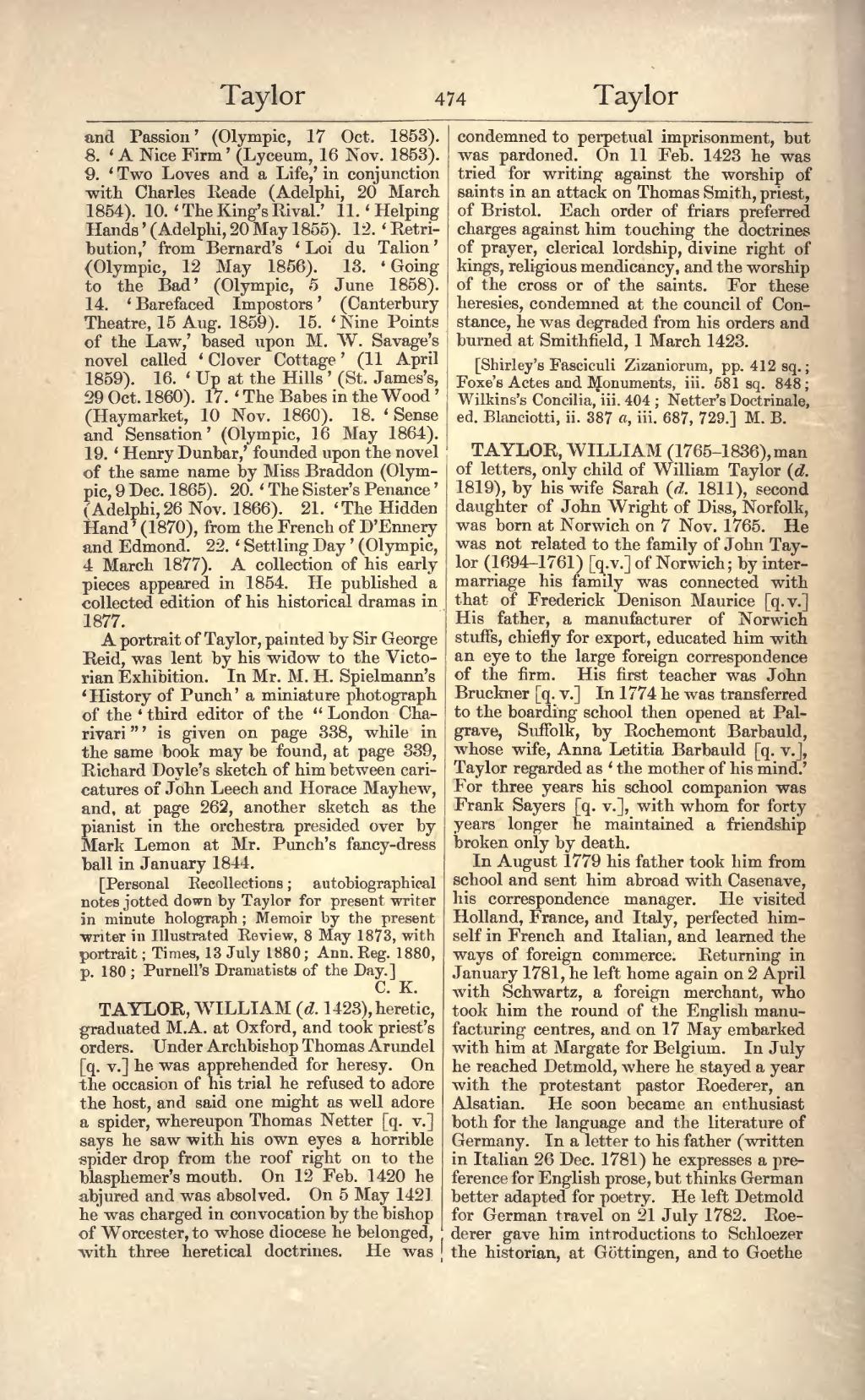- and Passion’ (Olympic, 17 Oct. 1853).
- ‘A Nice Firm’ (Lyceum, 16 Nov. 1853).
- ‘Two Loves and a Life,’ in conjunction with Charles Reade (Adelphi, 20 March 1854).
- ‘The King's Rival.’
- ‘Helping Hands’ (Adelphi, 20 May 1855).
- ‘Retribution,’ from Bernard's ‘Loi du Talion’ (Olympic, 12 May 1856).
- ‘Going to the Bad’ (Olympic, 5 June 1858).
- ‘Barefaced Impostors’ (Canterbury Theatre, 15 Aug. 1859).
- ‘Nine Points of the Law,’ based upon M. W. Savage's novel called ‘Clover Cottage’ (11 April 1859).
- ‘Up at the Hills’ (St. James's, 29 Oct. 1860).
- ‘The Babes in the Wood’ (Haymarket, 10 Nov. 1860).
- ‘Sense and Sensation’ (Olympic, 16 May 1864).
- ‘Henry Dunbar,’ founded upon the novel of the same name by Miss Braddon (Olympic, 9 Dec. 1865).
- ‘The Sister's Penance’ (Adelphi, 26 Nov. 1866).
- ‘The Hidden Hand’ (1870), from the French of D'Ennery and Edmond.
- ‘Settling Day’ (Olympic, 4 March 1877).
A collection of his early pieces appeared in 1854. He published a collected edition of his historical dramas in 1877.
A portrait of Taylor, painted by Sir George Reid, was lent by his widow to the Victorian Exhibition. In Mr. M. H. Spielmann's ‘History of Punch’ a miniature photograph of the ‘third editor of the “London Charivari”’ is given on page 338, while in the same book may be found, at page 339, Richard Doyle's sketch of him between caricatures of John Leech and Horace Mayhew, and, at page 262, another sketch as the pianist in the orchestra presided over by Mark Lemon at Mr. Punch's fancy-dress ball in January 1844.
[Personal recollections; autobiographical notes jotted down by Taylor for present writer in minute holograph; Memoir by the present writer in Illustrated Review, 8 May 1873, with portrait; Times, 13 July 1880; Ann. Reg. 1880, p. 180; Purnell's Dramatists of the Day.]
TAYLOR, WILLIAM (d. 1423), heretic, graduated M.A. at Oxford, and took priest's orders. Under Archbishop Thomas Arundel [q. v.] he was apprehended for heresy. On the occasion of his trial he refused to adore the host, and said one might as well adore a spider, whereupon Thomas Netter [q. v.] says he saw with his own eyes a horrible spider drop from the roof right on to the blasphemer's mouth. On 12 Feb. 1420 he abjured and was absolved. On 5 May 1421 he was charged in convocation by the bishop of Worcester, to whose diocese he belonged, with three heretical doctrines. He was condemned to perpetual imprisonment, but was pardoned. On 11 Feb. 1423 he was tried for writing against the worship of saints in an attack on Thomas Smith, priest, of Bristol. Each order of friars preferred charges against him touching the doctrines of prayer, clerical lordship, divine right of kings, religious mendicancy, and the worship of the cross or of the saints. For these heresies, condemned at the council of Constance, he was degraded from his orders and burned at Smithfield, 1 March 1423.
[Shirley's Fasciculi Zizaniorum, pp. 412 sq.; Foxe's Actes and Monuments, iii. 581 sq. 848; Wilkins's Concilia, iii. 404; Netter's Doctrinale, ed. Blanciotti, ii. 387 a, iii. 687, 729.]
TAYLOR, WILLIAM (1765–1836), man of letters, only child of William Taylor (d. 1819), by his wife Sarah (d. 1811), second daughter of John Wright of Diss, Norfolk, was born at Norwich on 7 Nov. 1765. He was not related to the family of John Taylor (1694–1761) [q. v.] of Norwich; by intermarriage his family was connected with that of Frederick Denison Maurice [q. v.] His father, a manufacturer of Norwich stuffs, chiefly for export, educated him with an eye to the large foreign correspondence of the firm. His first teacher was John Bruckner [q. v.] In 1774 he was transferred to the boarding school then opened at Palgrave, Suffolk, by Rochemont Barbauld, whose wife, Anna Letitia Barbauld [q. v.], Taylor regarded as ‘the mother of his mind.’ For three years his school companion was Frank Sayers [q. v.], with whom for forty years longer he maintained a friendship broken only by death.
In August 1779 his father took him from school and sent him abroad with Casenave, his correspondence manager. He visited Holland, France, and Italy, perfected himself in French and Italian, and learned the ways of foreign commerce. Returning in January 1781, he left home again on 2 April with Schwartz, a foreign merchant, who took him the round of the English manufacturing centres, and on 17 May embarked with him at Margate for Belgium. In July he reached Detmold, where he stayed a year with the protestant pastor Roederer, an Alsatian. He soon became an enthusiast both for the language and the literature of Germany. In a letter to his father (written in Italian 26 Dec. 1781) he expresses a preference for English prose, but thinks German better adapted for poetry. He left Detmold for German travel on 21 July 1782. Roederer gave him introductions to Schloezer the historian, at Göttingen, and to Goethe
